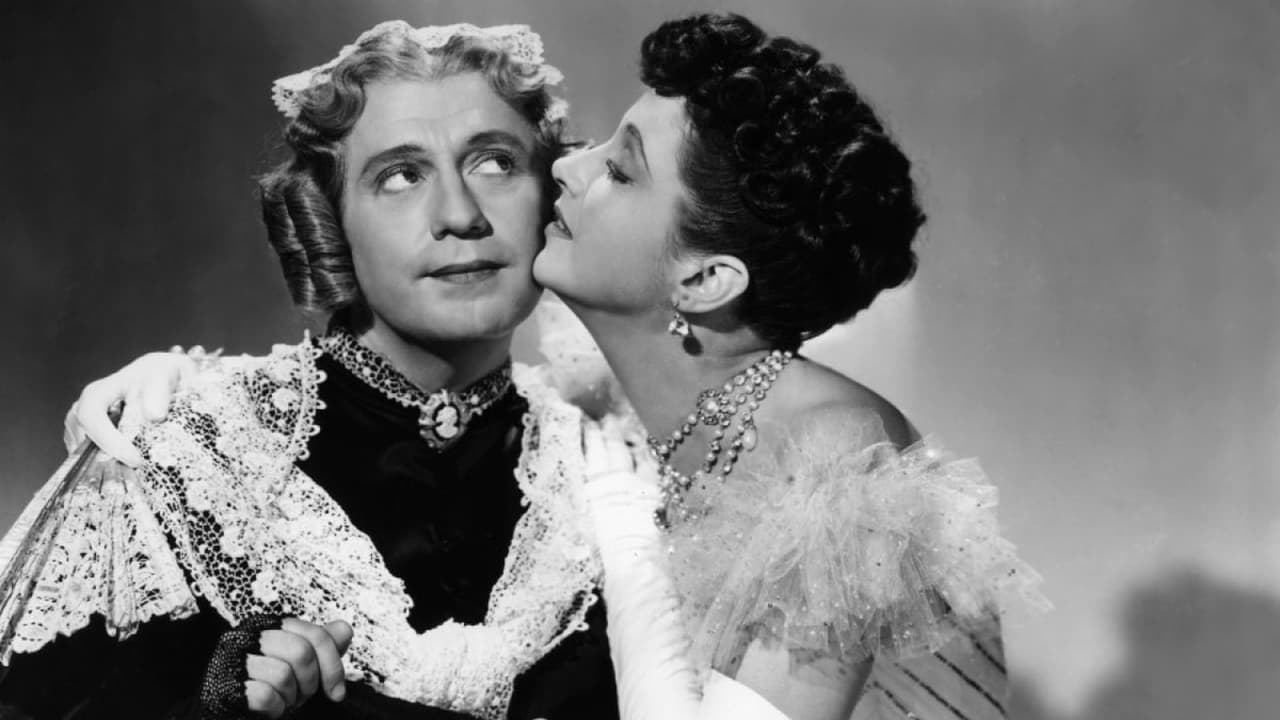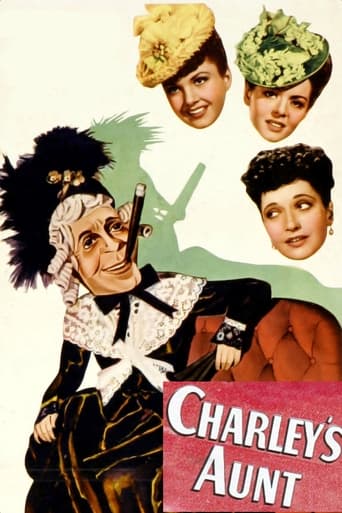

This perennial chestnut by Brandon Thomas has been wowing audiences ever since it opened in London in 1882. Charley's Aunt has had numerous stage revivals and more screen versions than most people can remember. When Jack Benny took it on in 1941, nearly 60 years after the London opening, the movie turned into one of his biggest hits. Now, nearly 65 years since the movie opened, it remains one of the funniest, most good-natured and most antic farce comedies around. Benny plays Babbs Babberley -- Lord Fancourt Babberley -- an aging student at Oxford in the year 1890. His two friends, Jack Chesney (James Ellison) and Charley Wyckham (Richard Hayden), are keen to marry, respectively, Kitty Verdun (Arleen Whelan) and Amy Spettigue (Anne Baxter). The girls are beautiful and sweet, and as shallow as tea saucers. But old skinflint Stephen Spettigue (Edmund Gwen), Kitty's ward and Amy's uncle, will have none of it. He will lose his income from Kitty's fortune when she marries. Then there is Jack's father, Sir Francis Chesney (Laird Cregar), who has inherited a title which has more debts attached than income. When the girls come to call on the two boys in their rooms at Oxford, it is essential that they have a chaperone. For reasons too complicated to explain, the chaperone, who was to be Charley's aunt, Donna Lucia (Kay Francis) from Brazil, has been delayed (but will shortly show up incognito). The boys blackmail their good friend Babbs to dress up as Donna Lucia and be the required chaperone. Ah, but then old Spettigue learns of Donna Lucia's wealth and decides to do some wooing of his own. Even Sir Francis, reluctantly conceding that an advantageous marriage would help the Chesney exchequer, decides to pursue Donna Lucia. And poor Babbs, now got up in a Victorian gown with corset, wig and fan, must fend them all off...over tea, in the garden, at dinner, by a garden pool, while trying to secretly smoke a cigar, while furtively trying to shave. Will Jack win Kitty? Will Charley win Amy? Will old Spettigue receive a comeuppance? Most importantly, perhaps, will Babbs wind up marrying Sir Francis or the real Donna Lucia? Benny plays Babbs with gusto and great timing, and spends most of his time in a dress. It's definitely a Jack Benny movie, but the play itself is so inherently ridiculous and funny, and so good-natured about every bit of stuffy Victorian manners and proper Victorian behavior, that it still works now as great light entertainment...just as the movie worked originally in 1941 and the play has worked for 125 years. I saw a regional production of Charley's Aunt some years ago; it really is a fast and funny farce, and depends heavily on the skill of the actor playing Charley's aunt. The movie, like the play, is funny and silly, and it does no harm. In addition to Jack Benny, two actors stand out for me. Edmund Gwen as Spettigue provides a classic lesson in how to play farce; utterly serious with the kind of timing that comes from experience. For those who know of Gwen primarily as an avuncular and kindly old Santa Claus, his Spettigue should be a welcome relief. And then there is Laird Cregar, an immensely gifted actor. Cregar was only 25 when he played Jack Chesney's father. The actor who played his son was 31. Cregar was a big man -- 6'3" and 300 pounds -- who disliked the idea of being type-cast as a bad-guy; he longed to be a lead actor. He went on an unsupervised crash diet, quickly shed 100 pounds and shortly after, at 28, died of a heart attack. He made his first movie in 1940 and was dead four years later. He could be so vivid and accomplished on screen that critics still speculate on what he might have accomplished. The movies he was in may not all have been first-rate, but he tended to focus attention whenever he appeared. Two movies which were as good as his talent, in my opinion, are Heaven Can Wait (1943) and I Wake Up Screaming (1941). The Lodger (1944) also stands up well, as I remember it. And although Blood and Sand (1940) is something of a melodramatic stew-pot, Cregar stands out. And perhaps one of these days the Frank Loesser estate, which I understand owns the rights, will release the 1952 movie Where's Charley?. The problem seems to be that the film, just as the stage production, is generally recognized as Ray Bolger's Where's Charley?, not Frank Loesser's Where's Charley?. Where's Charley was Frank Loesser's first Broadway show, produced in 1948. It featured career-defining performances for Ray Bolger as Charley Wyckham (who plays his own aunt) and Allyn Ann McLerie as Amy. There are some fine Loesser songs, including Once in Love with Amy and My Darling, My Darling. The movie may have its faults but it should be made available.
... View MoreJack Benny is "Charley's Aunt," in this 1941 film version of the famous play, one of several film re-creations that exist. Benny plays Fancourt Babberly, a somewhat older student at a British university in the late 1800s who, through a series of complications, winds up playing Donna Lucia of Brazil, the aunt of another student, Charley, because Charley and his friend Jack need a chaperone in order to have the dates they've planned. The late-arriving aunt is actually portrayed by the lovely Kay Francis, and wait until you catch the look on her face when she sees what's been impersonating her. As ridiculous looking as Fancourt looks in his drag attire, he manages to win the hearts of both the ward of one of the young women and the father of Jack Chesney, who pursue him relentlessly. Fancourt, meanwhile, finds the real Donna Lucia quite a strudel.There's nothing like a man in drag for laughs, and when the man is Jack Benny, watch out! Benny, famous for his long takes, is delightful here, and what makes him even funnier is that every once in a while, he says one word or another with a British pronunciation in the middle of a sentence where he's using his typical American accent. It had to be on purpose.The DVD of the film has a short publicity reel shown in theaters called "Three of a Kind," which has Benny in the 20th Century Fox commissary trying to explain his role to Tyrone Power and Randolph Scott as a bellhop asks his approval on a girdle, a dress and shoes. It's very good.Jack Benny was a wonderful actor and comedian with a great, dry, sometimes exasperated delivery. He made audiences laugh for years. Thanks to the existence of his radio shows and movies, he's still doing it.
... View More1941 was the season for two comedies starring the inimitable Jack Benny with Charley's Aunt released in 1941 and the filming of Ernst Lubitsch's To Be or Not To Be starring Benny and Carol Lombard in what was unfortunately her last film which was released early in 1942.Both are great ensemble films, and both stand the test of time. I find it difficult to say which of Benny's two characterizations I find the better; so, I must group them together as proof that Jack Benny was one of film's best but also one of its most under-appreciated comic actors.Benny is Charley's aunt just as he is Joseph Tura in To Be or Not To Be. Yes, some of Benny's persona with its slow takes that was a mainstay of his TV persona for so many years is evident in both films but, I might add, in entirely different ways and definitely in keeping wit the two roles.Benny is not just Benny but a great actor who has managed to assume the character of the two roles.Charley's Aunt continues to be performed and continues to be filmed; nevertheless, I recommend any film buff and any troupe planning on presenting Charley's Aunt to watch the Jack Benny version again and then again.
... View MoreI have also looked for a video of this for years and found it recently at the Forgotten Films web site. (Unfortunately, as of 2008 they seem to have gone out of business) The quality of the print is only fair. It is recorded at EP speed, but clear enough to enjoy the fun. Benny is very droll and Kay Francis looks like she's having a lot of fun. Edmund Gwenn turns in an almost madcap performance as well. Also look for Anne Baxter playing the ingénue. I think this is funnier than the Charlie Ruggles version, though the latter comes pretty close. I recommend the video only with the caveat mentioned above - at least it's a way to view the film. It's about time Fox Movie Channel or TCM finally aired this little stage gem on television, and whoever has the rights to it cleans it up and makes it available .
... View More